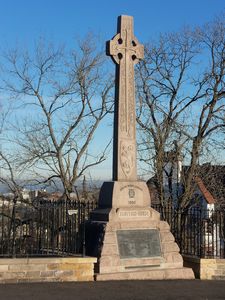Advertisement
Published: November 30th 2012

 A Celtic cross outside of Edinburgh Castle
A Celtic cross outside of Edinburgh Castle
This cross sat outside the entrance of Edinburgh Castle. It's dated 1900, and it's dedicated to soldiers.Today is St Andrew's Day! St Andrew is the patron saint of Scotland, and we so happen to be here on this holiday. Castles and cathedrals don't charge admission today, and so we took the opportunity to check out the sights. Admission is normally £14.50 a pop, so Saint Andrew saved us a pretty penny.
We cut through the Princes Street Gardens into Old Town and followed the Royal Mile up to Edinburgh Castle. I say "up" because the walk up to the castle is very steep. First, the castle is on top of an old volcano, giving it good height that I'm sure made it an ideal location for a fortress. Second, people have occupied that area for 3,000 years, and the road designs that were developed are very old. Andrew joked, "I don't think this is ADA compliant!"
There were a couple Celtic crosses outside the castle. We stopped and appreciated them and the view of Edinburgh below us for a bit, and then we proceeded into Edinburgh Castle. Many of the old, stone structures had dates on them, and others had modern plaques near the doors to describe when the various parts were built and how
they were used. Although there has been a royal castle at that site since the 12th century, most of the structures we saw dated from the 16th century to the turn of the 20th century.
Tables were set up in the Royal Palace for St Andrew's Day. Children decorated ornaments with the Scottish flag. We saw teachers with groups of preschoolers walking through the Great Hall (built in the early 16th century by King James IV). The tiny kids posed in front of all the weapons that decorated the walls and were positively adorable.
We entered Mary Queen of Scots' chambers. The walls were decorated with portraits of her and her son, King James VI. There was a closet attached to her chambers, and it's where King James VI (later King James I of England) was born in 1566. The walls of the closet were painted in honor of when he returned to Edinburgh in 1616. I was in awe over looking at paintings so old.
The tiny cobblestones provided good grip for us, and we walked around the castle grounds. We peeked out of murder holes and imagined the real people who must have manned them.
Parents plopped their kids on top of cannons from the 18th century and took funny photos.
One of my favorite parts of the castle was the Crown Room. There are no photos allowed in that part of the castle. The plaques and paintings in the room told a wonderful story. Apparently, a beautiful septor was given to King James IV (the king who created the Great Hall) by the Pope in 1494. The next Pope gave him a sword in 1507. His son, King James V (father to Mary Queen of Scots) had a crown made for his coronation. These three items became known as the Honours of Scotland, or the Scottish Crown Jewels. All three items were used for the the coronation of Mary Queen of Scots and continued to be used at the coronoations for the next century. King Charles had the Scottish Crown Jewels used in his coronation. He was executed after a civil war in England, but the Scottish people loved him and quickly named his son, King Charles the II, king. He was the last member of royalty to use the Scottish Crown Jewels. The English people didn't recognize him as king, and Oliver

 Edinburgh
Edinburgh
This is the view of Edinburgh from Edinburgh Castle.Cromwell defeated him and put him in exile. Apparently, the Crown Jewels were buried to keep them from Cromwell. After they were dug up, they were later locked in a chest, which was was sealed off in the early 18th century.
They were forgotten about for over 100 years, and then Sir Walter Scott was chosen to open the chest. He put all three pieces of the Scottish Crown Jewels on display. We got to see the pieces today in the Crown Room. There were people stationed in the room to keep anyone from taking photos. The septor was very intricately carved with leaves and just stunning. The crown, decorated in jewels, was also beautiful, but I was most surprised to see the sword. It's huge! Quite literally, it looked to be four feet long.
We spent about two hours at the castle. When we were done, we walked down the Royal Mile and peeked into gift shops. We sat in St Giles' Cathedral (14th century) and then made our way back to our bed and breakfast. We cut through Princes Street Gardens again in order to see the Scott Monument, built in honor of Sir Walter Scott.
Advertisement
Tot: 0.155s; Tpl: 0.014s; cc: 20; qc: 74; dbt: 0.1157s; 1; m:domysql w:travelblog (10.17.0.13); sld: 1;
; mem: 1.3mb
















